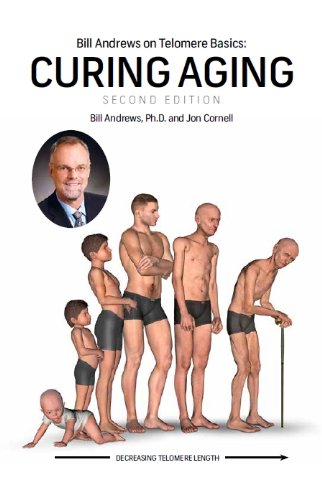For decades now researchers have been saying what they are learning from young children with a gene mutation that results in premature aging and a shortened life span could have application for the rest of humanity. Don’t believe it.
News headlines declare a breakthrough in progeria, the name given to this premature aging syndrome. Researchers claim by maintaining the length of end caps of chromosomes called telomeres they can push back against this genetic disorder.
 The Telomere Effect: A...
Best Price: $2.89
Buy New $7.99
(as of 05:40 UTC - Details)
The Telomere Effect: A...
Best Price: $2.89
Buy New $7.99
(as of 05:40 UTC - Details)
The prevalence of progeria is 1 in 4-8 million births. Progeroid children are prematurely old. There are only 145 of them in the world (~16 in the USA). They develop cataracts, wrinkled skin, become bald and die of a heart attack or stroke in their early teens. Progeria emanates from a mutation in the Lamin-A gene.
Researchers now say: “RNA therapeutics can reverse the shortening of telomeres and lengthen them in cells from children with progeria, then it may be possible to reverse a lot of the problems associated with aging.”
They claim a dramatic effect telomere-extending technology had on cells in a lab dish. And what they have demonstrated may be true for the few individuals with progeria, it will not likely translate into any health benefits for the rest of humanity. Here’s why:
The same research team reported two years ago that telomere therapy could potentially reverse premature aging via the provision of telomerase, the enzyme that maintains telomeres. However, all that has been accomplished has been demonstrated in a lab dish.
Telomere science is not without some credulity. It was recently reported that telomeres in some individuals become critically short (5 kilobase) and reach a brink at a younger age that engenders a risk for imminent death and shortened life expectancy. Analysis of present data suggests most individuals do not reach their telomere limit brink during the normal course of their life and that further extension of human longevity is possible.
 The Telomere Miracle: ...
Check Amazon for Pricing.
The Telomere Miracle: ...
Check Amazon for Pricing.
Researchers always want to justify a need for research funds. There are 1770 research papers published about progeria at the National Library of Medicine. The Progeria Research Foundation allots ~$1,000,000 a year in research grants for this disease. The number of researchers in the field (134) almost out=number the number of progeria children.
To date there are 526 reports published on the topic of telomeres and longevity. There are 4694 papers published on telomeres and aging. Telomere science has drawn fascination from researchers and the public alike.
But according to a recent research study individuals with long telomeres have about the same chance of developing cancer if they have short telomeres. This is now called the cancer-telomere paradox.
Three times this author has written to question the proposed telomere paradigm of aging. I’ve written telomeres are just a measure of oxidation and marker but not a governor of aging. I’ve cited studies that show telomerase-deficient mice do not age prematurely and the correlation between telomere length and aging is poor. The telomeres of birds actually lengthen as they age. There are many unexplained contradictions in telomere science. It has been shown that telomere length is not a predicdtor of successful aging in centenarians. In normal individuals (not progeria children) it is the accumulation of minerals that accelerates aging, not telomere length.
 Bill Andrews on Telome...
Best Price: $11.99
Buy New $15.98
(as of 02:15 UTC - Details)
Bill Andrews on Telome...
Best Price: $11.99
Buy New $15.98
(as of 02:15 UTC - Details)
But all is good for the research community. Keep the research grants coming. Progeria researchers are pursuing the synthetic drug model of progeria therapy. The Progeria Research Foundation reports on an expensive monoclonal antibody drug used in a preliminary study. The Progeria Research Foundation is a front for Big Pharma.
But rather than using high-technology to maintain telomeres researchers as researchers recently did, investigators recently proposed natural molecules found in green tea (catechins), spices (curcumin from turmeric), red wine grapes (resveratrol) to maintain telomeres, which are safe yet go untried among progeroid children.
It is more plausible that epigenetics can be employed to aid progeria children. Researchers now propose “that agents or interventions that can maintain epigenomic stability and facilitate the DNA repair process can slow down the progress of premature aging, if not completely prevent it.”
In fact, in 2012 researchers demonstrated that the activation of the Sirtuin1 survival gene by resveratrol, known as a red wine molecule, enhances binding of Sirtuin1 to Lamin-A and rescues stem cell decline which in turns slows down body weight loss, improves bone structure and extends the lifespan in an animal model of progeria.
 The Telomerase Revolut...
Best Price: $9.25
Buy New $11.11
(as of 08:20 UTC - Details)
The Telomerase Revolut...
Best Price: $9.25
Buy New $11.11
(as of 08:20 UTC - Details)
The following year researchers confirmed that resveratrol exerts “ameliorating effects on progeria and its capacity to extend lifespan in progeria mice.”
Just in case telomere lengthening IS the holy grail for progeria, resveratrol has been demonstrated to promote telomerase, the enzyme that facilitates repair of DNA mutations.
While there has been considerable debate on whether resveratrol directly activates the Sirtuin1 survival gene, of acute interest is the finding that resveratrol activates the Sirtuin1 survival gene by binding to Lamin-A, the very gene that is mutated in progeria children.
So why are the progeria children not being given resveratrol? And what about the rest of humanity?





